
Visit the European Parliament
06 April 2022

When in Brussels, take the chance visit the beating heart of Europe and get an insight into the largest transnational parliament in the world. From the Hemicycle to the screens of the Parlamentarium and from history to the debates of today, the European Parliament opens itself up to citizens and to the rest of the world.
The European Parliament Hemicycle
WARNING! The Brussels hemicycle will be closed for Christmas from 24 December 2023 to 3 January 2024. Visit the Hemicycle, the heart of the European Parliament in Brussels, where Members of the European Parliament (MEPs) hold their debates and take crucial votes for Europe. A visit to the Hemicycle is a great way to soak up the exciting atmosphere of the world’s largest transnational parliament. Come and find out about its powers and role and discover how your MEPS represent you. If you time your visit right, you might also be lucky enough to follow a plenary session from the visitors’ gallery. * Free * Free multimedia-guided visits, available in 24 languages * Interactive talks by experienced speakers: Mondays at 11:00 and 15:00 (in English and in French) * Book online: see practical information * A valid proof of identity is required (passport, identity card, etc.).

Parlamentarium
Please note! The Parlamentarium will be closed on 24, 25 and 31 December 2023 and on 1 January 2024. Have you ever wondered how the European Union works and how it affects your daily life? The Parlamentarium has it covered! Thanks to its interactive tools like a 360° cinema, a role play game for students and a giant interactive floor map, you’ll learn everything there is to know about the European Parliament. Discover the path that led to today’s European Union and what Members of the European Parliament are doing to tackle Europe’s biggest challenges. * Free * Available in 24 languages * Book online : see practical information

House of European History
Get ready for a journey like no other! The permanent exhibition begins with the myth of the goddess Europa, exploring Europe’s ancient roots and the continent’s heritage of shared traditions, before Europe’s dramatic journey towards modernity in the 19th century and rebuilding process following World War II. A multimedia guide in 24 languages gives you new ways to interact with the exhibition, while special activities and Family Discovery Spaces allow children to grasp the story of Europe. Located next to the European Parliament in a striking Art Deco building in Parc Léopold, the House of European History is an essential part of any tour of the city. * Free * Available in 24 languages * Book online: See practical information
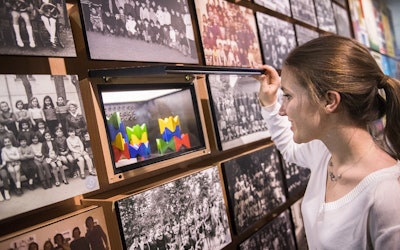
Please note! Closed on 24, 25 and 31 December 2023 and on 1 January 2024. Dive into the topics you are interested in with open access research material, policy talks and civil society events, and thought-provoking exhibitions at the heart of the European Quarter. With distinct areas offering access to a variety of content and activities, the Info Hub on the Esplanade Solidarność 1980 caters to many needs. Engage in a dialogue on the European Union and democracy, attend a short policy talk, or simply sit and read more about what is going on in Europe. What is more, with a constantly changing programme of events and exhibitions, you can come back time and time again, and discover something new each time. Got a question? Ask the friendly staff and they will help you find your way around the Info Hub, or the European Parliament campus.
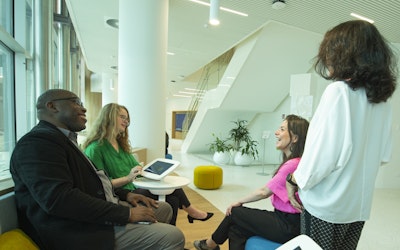
Digital Journey to the European Parliament
Are you ready for an online voyage of discovery? With the Digital Journey to the European Parliament, a free online and immersive experience, you can dive deeper into European democracy from wherever you are. Discover the Parliament in 360°, meet its Members for a day and have your own time-travelled adventure through European History. Enjoy full immersion to the European Parliament on your computer or in virtual reality with VR-glasses. Stroll through the corridors of the Parliament in Brussels and Strasbourg, tour the office of President Roberta Metsola and even explore the House of European History’s permanent exhibition. From whenever you are. Whenever you want. Get started: ep-digital-journey.eu * Free * Available in 24 languages

Segments of the Berlin Wall at the European Parliament
Did you know that Brussels is home to several sections of the infamous Berlin Wall. For almost 30 years, this physical and ideological barrier symbolised the intractable division of the European continent into two camps: the liberal and capitalist West and the communist East. In addition to dividing Europe, it also harks back to the Cold War and a global hiatus. Nowadays, sections of the Wall can be found all over Europe and even beyond. There are pieces in Strasbourg, Tallinn, Reykjavik, New York, Seoul and... Brussels, of course! You’ll find four original sections of the Berlin Wall in Brussels. Two are showcased near the entrance to the European Parliament, by Léopold Park. They have stood there since 2021, each encased in a glass box, the result of a project to protect them co-organised by the Belgian State, the Brussels-Capital Region and the European Parliament. While a lot of the graffiti was applied when the Wall divided Berlin in two, artists continued to decorate the Wall after it fell. The piece in the left-hand showcase recalls, not without a slight error, the memory of a momentus international sporting event in 2009: the figures of the new - and still current! - 100m world record, set by Usain Bolt in Berlin. The artist made a mistake: the time was 9.58 and not 9.85! But how did these pieces of the Wall get there? One of them was donated by the city of Berlin to the European capital in 2004. The second arrived in Brussels in 2009, as part of the celebrations marking the 20th anniversary of the fall of the Wall. On this occasion, ten sections of the former dividing line were installed in Brussels, on Place du Luxembourg. A few months later, all but a few returned to Germany. This dichotomy between the values defended by Europe - unity, togetherness, the rejection of division - and the situation in Berlin and Germany, which until 1989 was characterised by separation and partition, is quite remarkable!

Explore also...
European quarter explorer app.
The European Quarter Explorer is a web application that leads you to discover one of the most eclectic and international neighbourhoods of Brussels, the European Quarter.

Brussels, 24 hours in the European Quarter
Discover our 5-step itinerary and immerse yourself, for a day, in the authentic and diverse European Quarter where languages and cultures coexist beautifully. Are you ready to burst the "European bubble" and shatter any preconceptions you might have had about this neighbourhood?
Neighbourhood Walk: the European Quarter
It has much more to offer than just a monofunctional office district
Visit a European Union institution
Welcome to the eu institutions.
The European Union institutions are open to visitors from around the world to learn more about the EU and get an understanding of their work.
With sites in several major European cities, the institutions offer a variety of options to visitors. Some institutions provide interactive on-site visitor centres, some allow physical access to their buildings, and some organise tailor-made presentations and discussions involving their staff.
Whatever form a visit to an EU institution takes, visitors are guaranteed an interactive and educational experience. Students and tourists alike will see and learn first-hand how the EU works. And have fun, too.
Open Day and virtual tours
Each year, to celebrate Europe Day , the EU institutions open their doors to the public in early May in Brussels and Strasbourg. Local EU offices in Europe and across the world organise a variety of activities and events for all ages.
The EU’s Open Day offers a unique opportunity for you to discover how the European institutions affect your life. You can step inside the buildings and take part in special activities, such as public debates and guided tours.
And if you can’t visit in person, you could always take a ‘virtual tour’. Several institutions offer virtual access to their buildings, so you can discover how the EU works from the comfort of your own home.
Click on each city section to open a full list of the possible venues, along with a link for more detailed information.
Brussels (Belgium)
European Parliament

The European Parliament has a number of venues in Brussels, for individual or group visits. This includes the ‘hemicycles’ where EU laws are debated and voted on, the EU’s interactive visitor centre - the Parlamentarium - the House of European history and Station Europe.
Plan your European Parliament visit (Brussels)
European Council / Council of the EU

Step inside the Council, discover the buildings where EU leaders meet and learn how the Council shapes Europe's future. To visit the Council, you can either explore our visitor centre and the public areas on your own or take part in our weekly guided tours.
Plan your Council visit
European Commission

The European Commission has different visit venues in Brussels. This includes the Commission’s Visitors’ Centre where groups wishing to discover the Commission and its policies can hear directly from Commission officials. Visits should be booked at least 10 weeks in advance, and can be tailored to groups’ needs. Experience Europe is the interactive exhibition centre of the Commission at the Schuman roundabout (300m from the Visitors’ Centre). No prior registration required for individual visitors or groups of less than 10 persons. Open 7 days a week.
European External Action Service

The European External Action Service welcomes group visits to its headquarters in Brussels. Find out how the External Action Service manages EU diplomatic relations with countries outside the European Union, carrying out the EU’s common foreign and security policy. All visits are tailor-made.
Plan your visit to the European External Action Service
European Economic and Social Committee

The European Economic and Social Committee (EESC) welcomes visitors to its headquarters in Brussels for an interactive presentation on its activities and its role in the decision-making process. Virtual group visits can also be arranged.
Plan your visit to the European Economic and Social Committee
European Committee of the Regions

The European Committee of the Regions (CoR) organises information visits at its premises in Brussels. Find out how the CoR works and the role of the regions in shaping the content of EU legislation. Virtual visits are also possible.
Plan your visit to the Committee of the Regions
European Data Protection Supervisor

The European Data Protection Supervisor (EDPS) welcomes specialist groups - such as students at post-graduate level - to its premises in Brussels to learn about what it does and how it works. Only official requests (e.g. from an official organisation email address) are considered.
Request a visit to the European Data Protection Supervisor
Strasbourg (France)

The European Parliament welcomes individual or group visits to its ‘hemicycle’ building in Strasbourg. See where the Parliament’s most important debates and votes are held before visiting the Simone Veil Parlamentarium, an interactive exhibition offering insight into the Parliament’s role and work.
Plan your European Parliament visit (Strasbourg)
The European Parliament offers guided tours of its Robert Schuman building in Luxembourg. Visit the site of the first administrative seat of the European Parliament and see its ‘hemicycle’ building during your group tour.
Plan your European Parliament visit (Luxembourg)
Court of Justice of the European Union
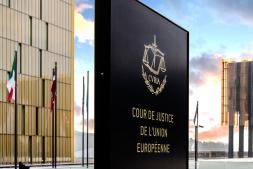
The Court welcomes individual or group visits to its site in Luxembourg. Attend a public hearing at the Court of Justice or the General Court, or take a guided tour of the buildings and the various works of art, donated or loaned to the Court by EU countries, which reflect Europe’s varied cultural heritage.
Plan your visit to the Court of Justice
European Court of Auditors

The European Court of Auditors (ECA) organises group visits to its site in Luxembourg. Visits involve a presentation by an ECA official on the role and workings of the Court, followed by a discussion. You must book at least 2 months in advance.
Plan your visit to the European Court of Auditors
European Investment Bank

The European Investment Bank admits groups of visitors to its premises in Luxembourg on receipt of a written request. Visitors must have a direct professional interest in the bank’s activities or be university students studying economics or finance.
Request a visit to the European Investment Bank
Frankfurt (Germany)
European Central Bank

The European Central Bank (ECB) offers a number of options to visitors, to explore what its work entails and the activities it supports in Frankfurt. Take a tour of the ECB’s Visitor Centre, attend a tailored lecture or visit its art collection.
Plan your European Central Bank visit
Further information
Role and work of the EU institutions
Share this page

How to visit the European Parliament in Brussels and the EU Quarter
One of the most interesting things to do in Brussels is to visit the European Parliament and see the EU Quarter, a surprisingly attractive and fascinating part of Brussels. Here’s how to go on a tour of the European Parliament and pay a visit to the other key buildings and attractions of the EU Quarter.
Where is the EU quarter in Brussels?
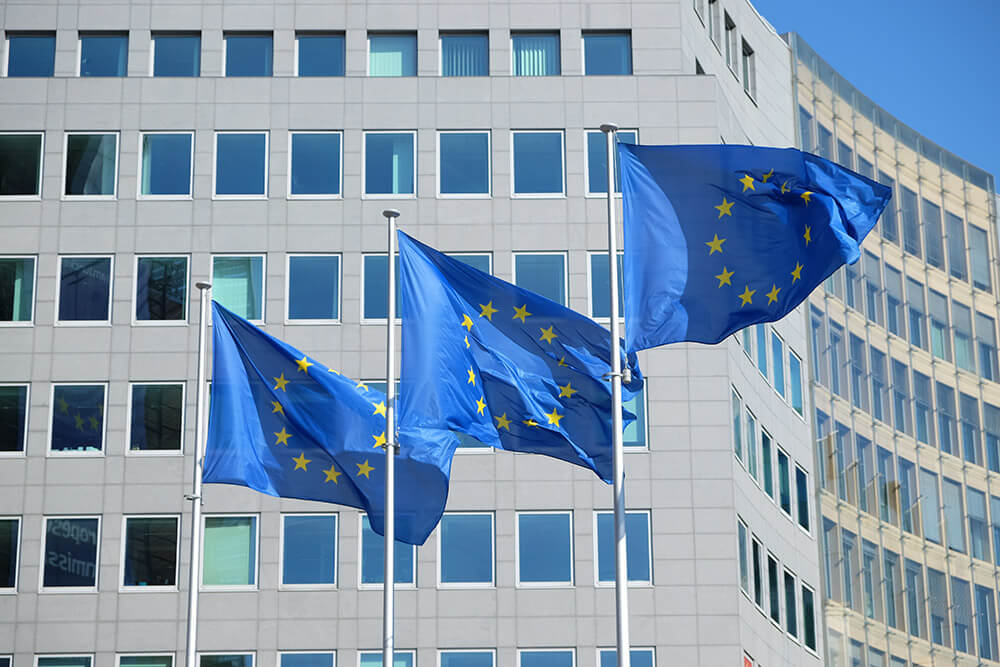
The EU or European Quarter, also known as the Leopold Quarter, is a compact area to the south-west of Brussels city centre, about 1.5 miles (2km) from the Grand-Place. In the 1800s the Leopold Quarter was one of Brussels’ most prestigious neighbourhoods, and there are lots of beautiful old buildings left over from those days.
During the early 20th century, the wealthy residents of the Leopold Quarter moved further outside the city centre to the new suburbs. Office buildings replaced many of the mansions, and in the late 1950s, new European institutions moved in.
Today the area is dominated by politics and business but it’s still surprisingly green and attractive, with beautiful parks and squares. There are also plenty of things to see and do in this part of Brussels.
Read more: How to see the best of Brussels in 48 hours
How to get to the European Quarter
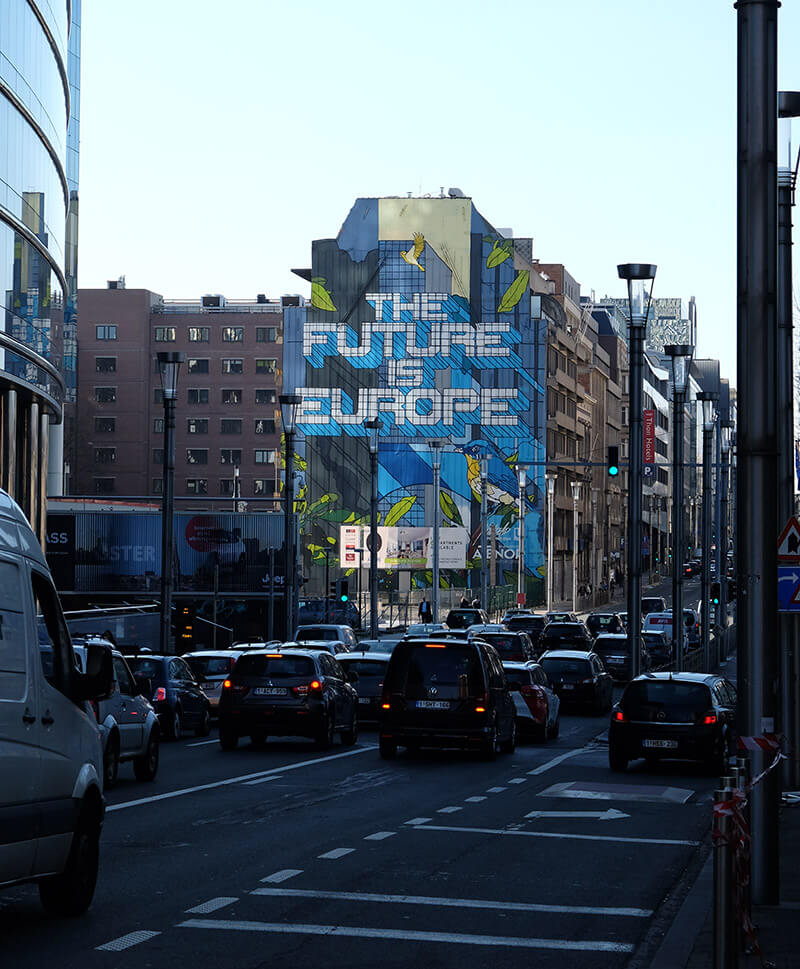
As you’d expect, this international meeting-point is well-connected to the rest of Brussels, as well as to the airport and European high-speed trains.
From the Grand Place, Bourse and the historic centre
To get to the EU Quarter from the Grand Place, take bus 95. It’ll take about 12 minutes to travel to Place du Luxembourg, outside the European Parliament.
From Brussels Midi
To get to the buildings of the European Quarter from Brussels Midi, the main inter-city and international train station in Brussels, take Metro line 2 to Trône. From Trône it’s around a 7-minute walk to Place du Luxembourg.
From Brussels Airport
If you’re coming straight to the EU Quarter from Brussels Airport, take bus route 12. The journey takes about 35 minutes.
From elsewhere in Brussels
A number of bus lines serve the European Quarter. The nearest Metro stops are Maelbeek and Schuman on lines 1 and 5, and Trone on lines 2 and 6.
Things to do in Brussels’ European Quarter
The european parliament: how to visit.
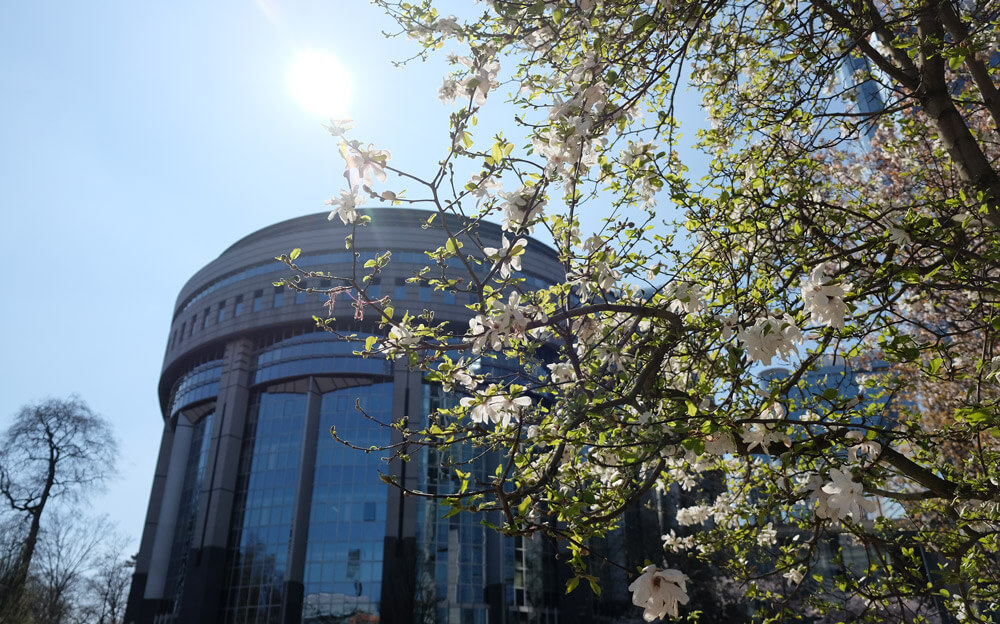
The most significant attraction in the EU quarter is the European Parliament. To visit the European Parliament and the famous hemicycle debating chamber as an individual, you’ll need to take one of the self-guided tours, which run at set times, Monday to Friday. Information about timings for the European Parliament tours are available on the Parliament website .
To join a tour, go to the rear entrance of the European Parliament building, just off Rue Wiertz. There are clear signs to get you to the right place from the front of Espace Léopold and Place du Luxembourg (follow the signs for the Hemicyle), but once at the door there’s not a lot to indicate that it’s ok to go in. Don’t worry; if you’re there at the right time just push open the door.
Read more: Visiting all the European Union capitals
You’ll be asked to show your passport, then you’ll go through airport-style security before picking up a headset and electronic guide. Although you can only take the EU Parliament tour at designated times, it’s a self-guided tour with the headset rather than a fully guided tour. The electronic tour is available in all EU languages – you can even download it as an app onto your own mobile phone rather than take a headset if you prefer. There are also printed guidebooks available in all EU languages which you can take away with you for free.
The first exhibit is an arrangement of all the flags of the EU member states – great for a photo opportunity. Once you’re through security, it’s ok to take as many photos or videos as you want inside the European Parliament building.
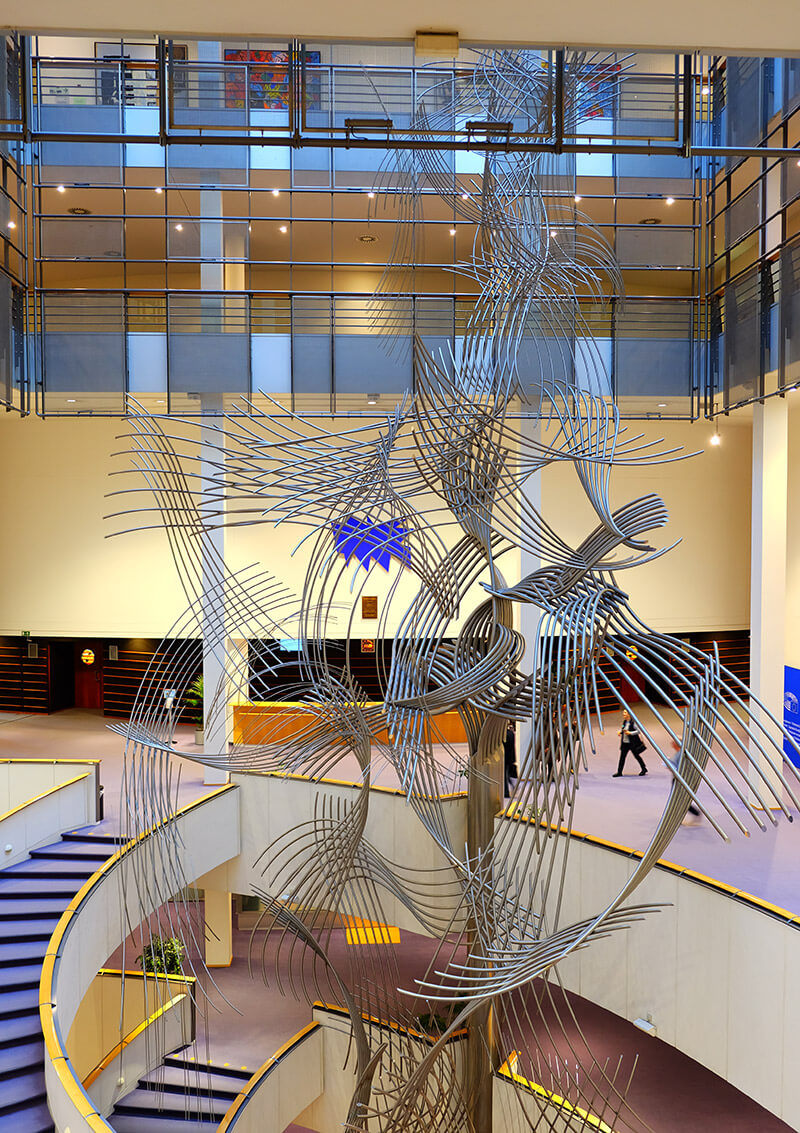
From the flags, you go up in a lift to the atrium where you can see a large sculpture representing cooperation between the member countries. The building is decorated with an art collection of works by up-and-coming European artists on themes of peace and cooperation.
After you leave the atrium, the next stop is the Hemicycle – the main debating chamber of the European Parliament in Brussels. Each EU member country elects representatives in the same way as they would for a national parliament. These Members of the European Parliament (MEPs) meet here and in Strasbourg.
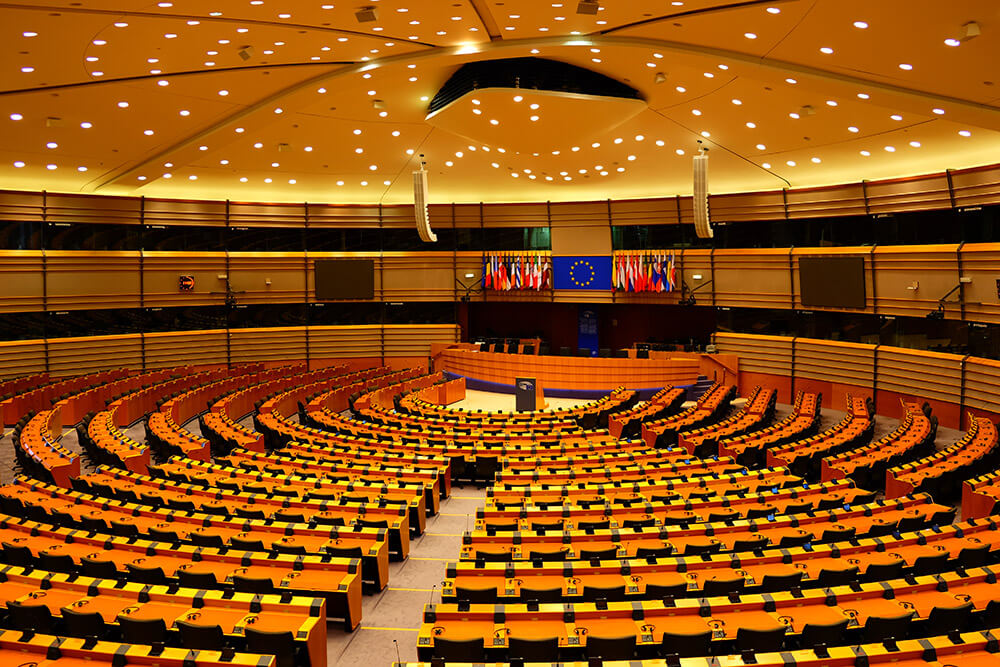
The tour finishes after you’ve seen the Hemicycle. All together, your visit will last between 30-60 minutes. Visiting the European Parliament is free – just don’t forget your passport.
Station Europe
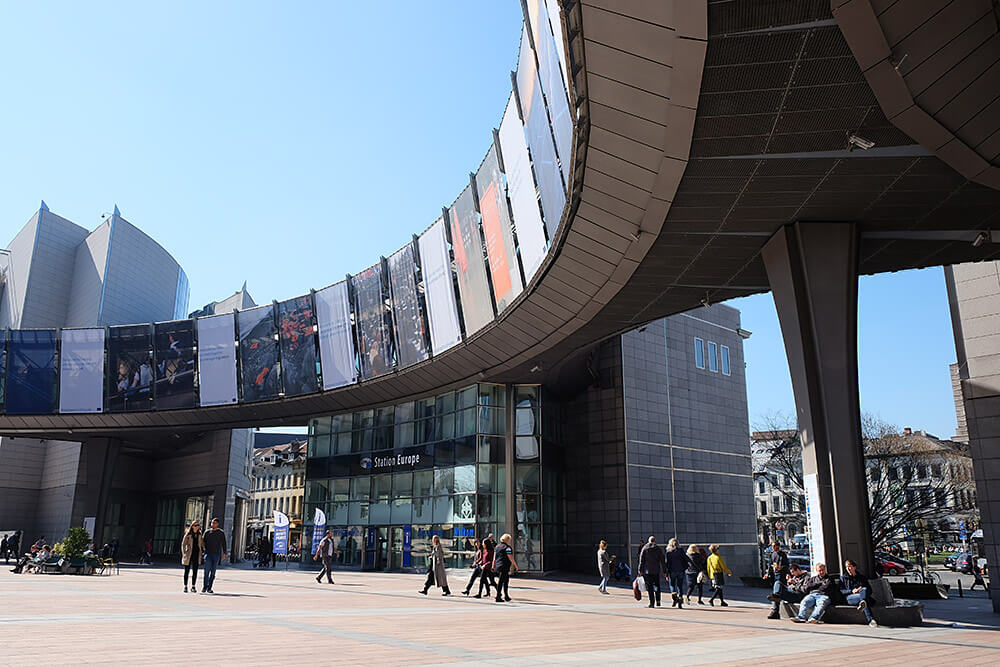
The original station buildings of the Brussels-Luxembourg train station now house a welcome centre for the European Quarter. You can get your bearings here, pick up a map and plan your visit to the area. There’s also a branch of the official Visit Brussels tourist information centre.
Between Station Europe and the buildings of the Espace Léopold (the name of the European Parliament complex) you’ll find a public square with chairs set up in circles, seemingly to encourage discussion.
Parliamentarium
If you want to understand more about the EU and the European Parliament, visit the Parliamentarium . The Parliamentarium is the EU Parliament’s official visitor centre, and has longer opening hours than the Parliament itself, so it’s a great option if you can’t make one of the Parliament tours.
Like the European Parliament tour, visiting the Parliamentarium is free. The entrance is just off Espace Léopold, towards Rue Montoyer.
House of European History
For an exploration of Europe’s turbulent history, and the events that led up to the formation of the European Union, visit the House of European History in Léopold Park.
The House of European History aims not to tell the story of each individual country in Europe, but to draw together the themes that European nations have in common. The permanent exhibition covers Europe as a global force in the 19th century and the two World Wars that shattered the continent, before examining the political divisions of the second half of the 20th century.
The exhibitions are free to visit, and a multimedia tour is available in all the EU languages.
Berlaymont Building
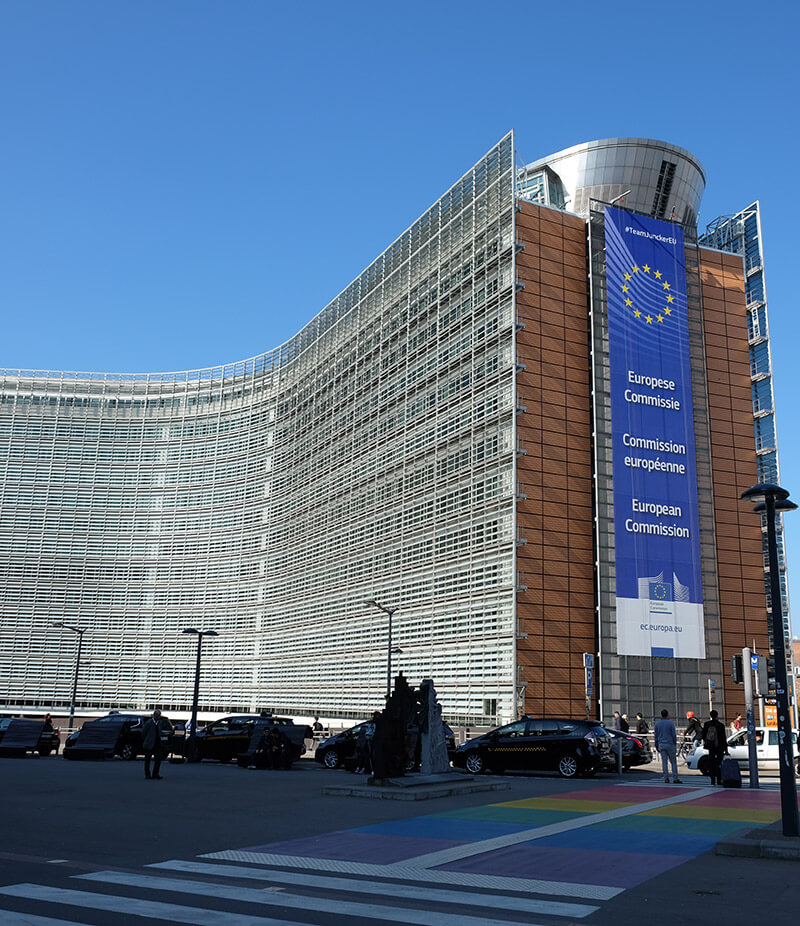
While you can’t go inside the Berlaymont Building, it’s an impressive sight and is probably the most iconic building of the European Quarter. The Berlaymont Building is the home of the European Commission, where the day-to-day work of the EU is carried out.
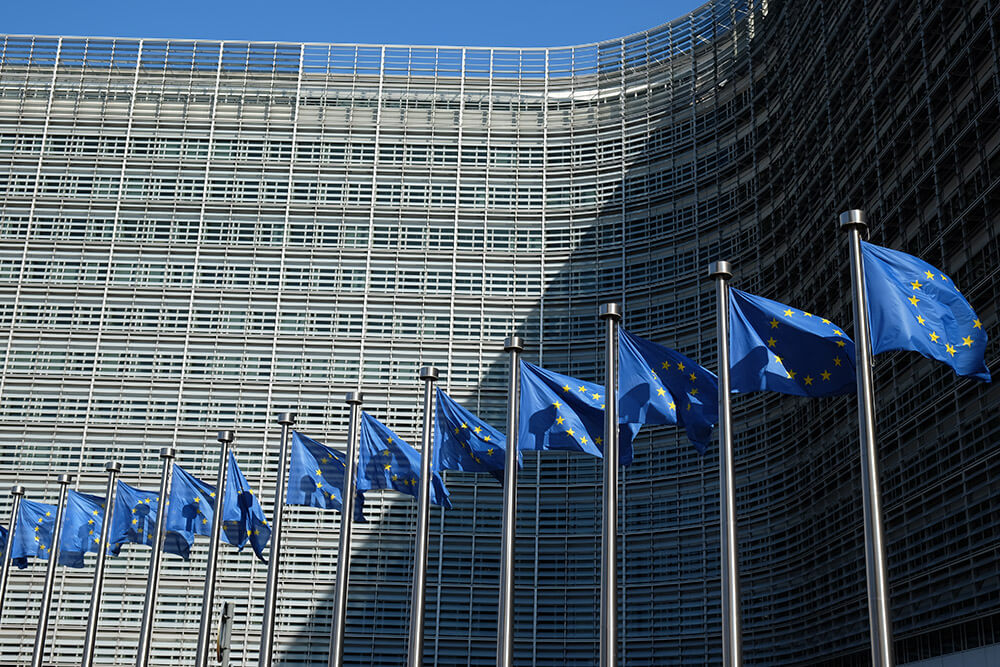
You can walk around the Berlaymont building; there are information boards about the history of the building spread out around the perimeter. If you’re lucky, you might see a TV news crew filming a report.
Statue of Europe
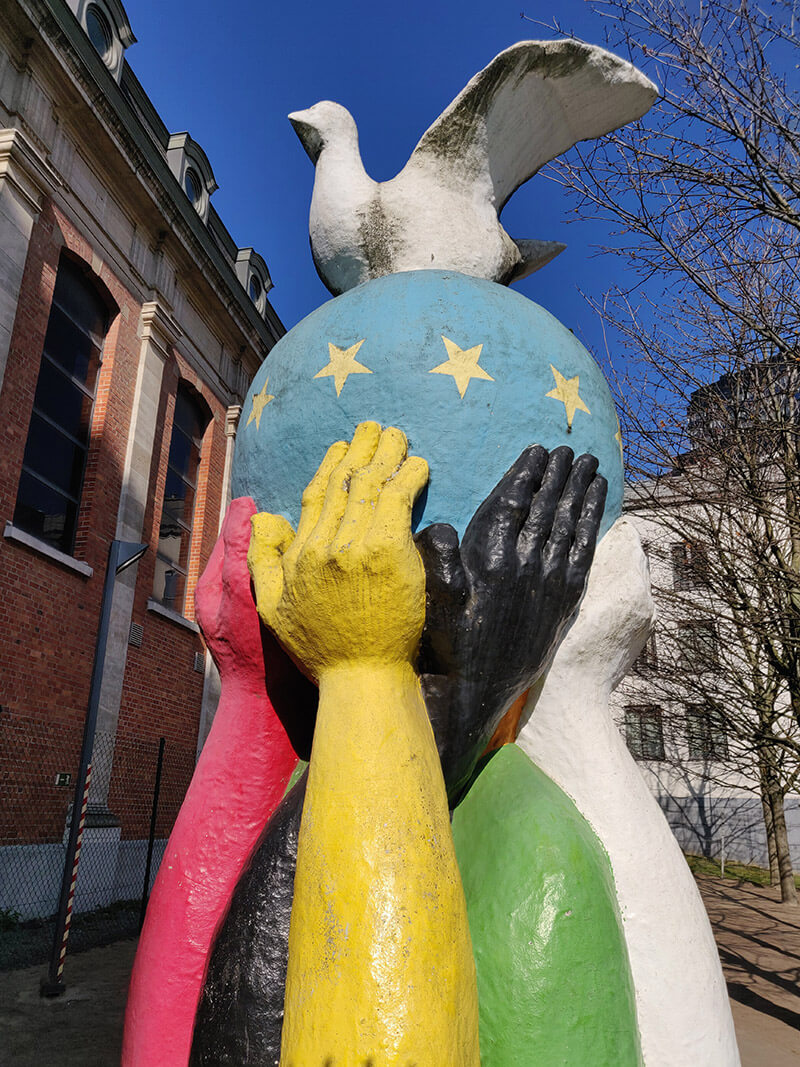
The Statue of Europe is a 5-metre tall sculpture symbolising peace in Europe and also the European Union motto, United in Diversity. Hands painted in different colours raise up a globe decorated with the EU stars, with a white dove perched on top.
The Statue of Europe is in the grounds of the former Convent Van Maerlant, now the library of the European Commission.
Other sights in and near the EU Quarter
Léopold park.
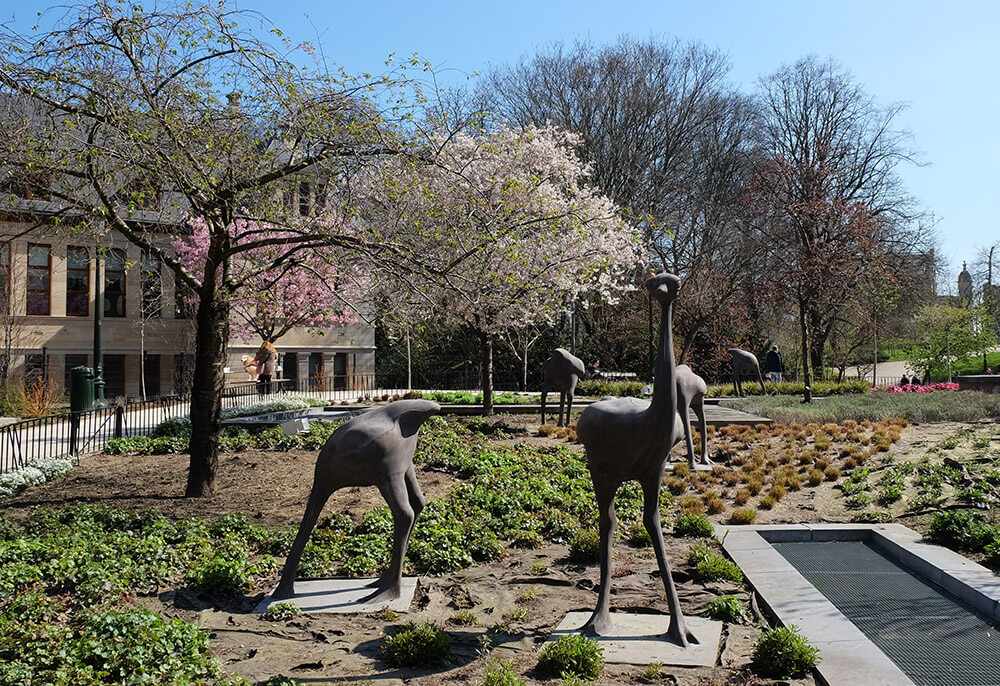
A pretty patch of green in the middle of the European Quarter, Léopold Park was the site of a zoo until the 1880s – symbolised by a quirky and controversial group of ostrich sculptures right outside the Parliament building.
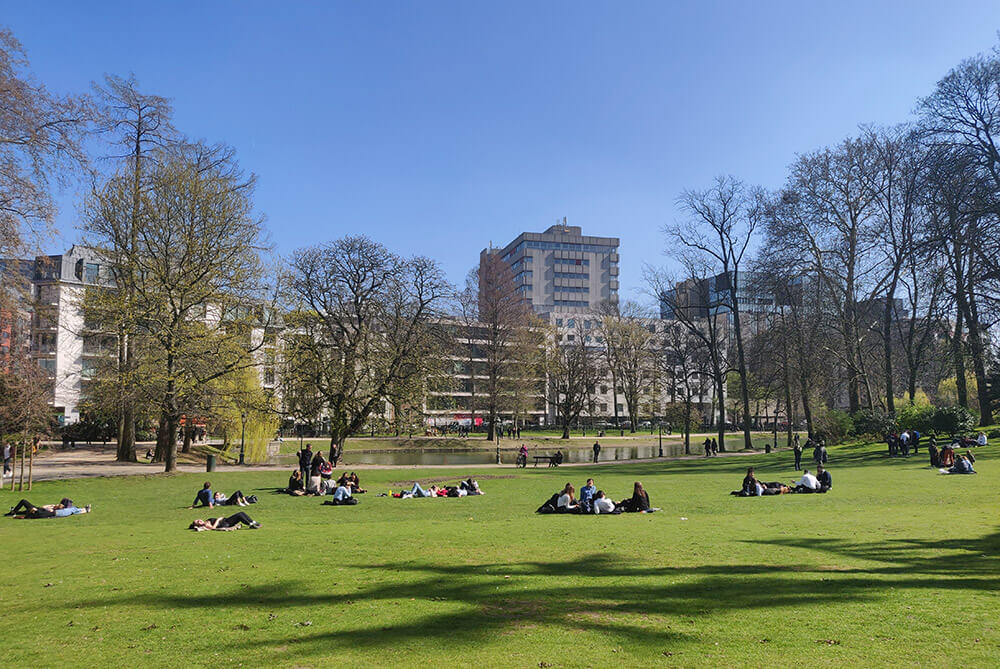
With rolling green hills, benches for an outdoor lunch and a beautiful lake, it’s the perfect spot to take a break in the European Quarter.
Parc du Cinquantenaire
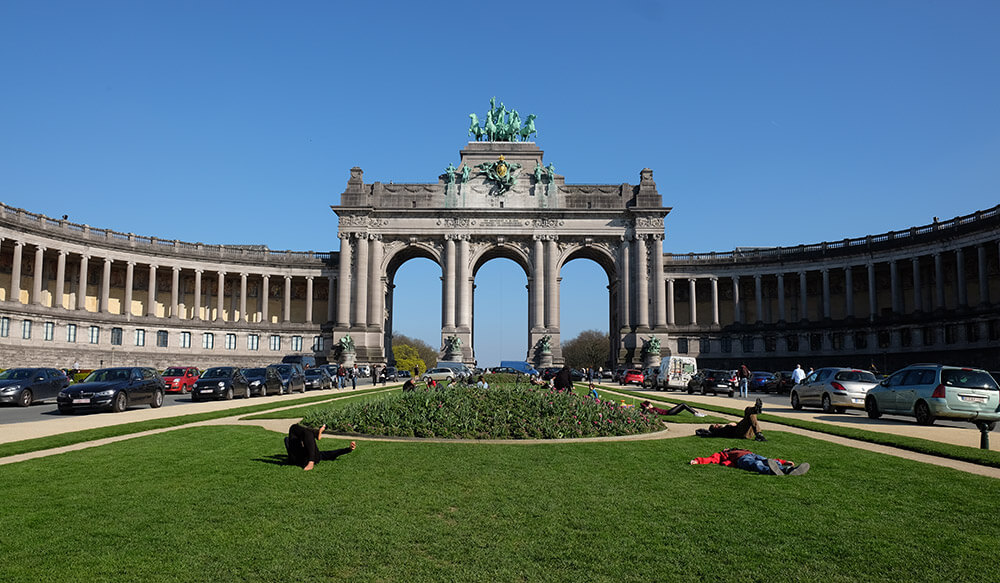
If you look west along Rue de la Loi, you’ll see an enormous triumphal arch, reminiscent of the Brandenburg Gate in Berlin. The arch itself is slightly more recent but the buildings either side were built for the 1880 National Exhibition which celebrated the Belgian nation’s 50th birthday.
The park itself is a very pleasant place for a walk, with lots of flowers, trees and lawns, and it’s a popular place for tourists and Brussels residents alike to relax.
Royal Military Museum
The Royal Military Museum occupies the left-hand side of the Cinquantenaire buildings. It holds an impressive collection of arms, armour, vehicles and aircraft. There are also two galleries dedicated to the First World War which devastated much of Belgium.
For an incredible view of the European Quarter and the surrounding area, take the stairs inside the Military Museum up to the viewing gallery on top of the arches.
On the right-hand side of the Cinquantenaire arch you’ll find Autoworld, a fantastic museum dedicated to cars and driving. Among the gleaming permanent exhibits and fascinating temporary exhibitions you’ll find information about Belgium’s contribution to automotive history.
Art & History Museum
The right-hand side of the complex also houses the Art and History Museum . More informative than an art gallery, more inspiring than a history museum, the unique collection eventually wants to be as well known as the British Museum or the Louvre.
Cauchie House
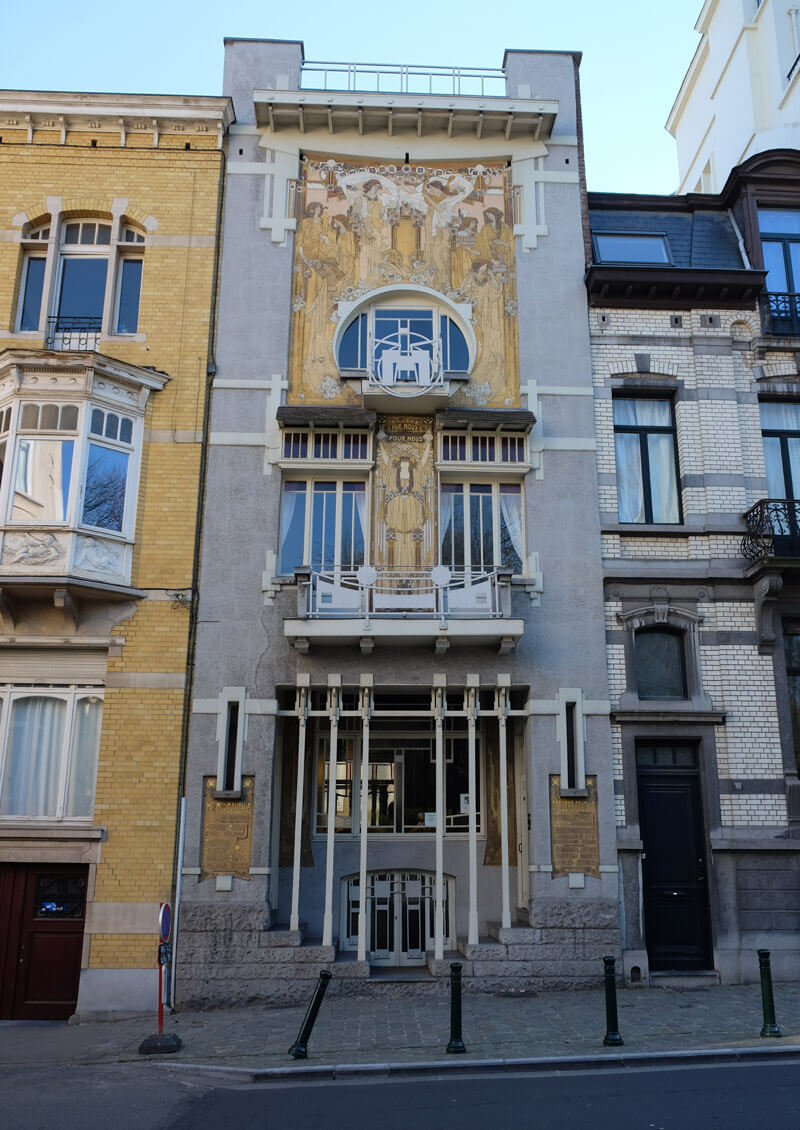
If you’re interested in architecture, and especially if you’re a lover of Art Nouveau, you can’t miss the Cauchie House . Artist couple Paul and Carolina Cauchie built the house in 1905 and decorated the front as an advertisement for their businesses; graphic design for him, art lessons for her. In the centre of the facade you can read the words “Par Nous, Pour Nous” – “By Us, For Us”. The house is at the top of Rue des Francs, just across the road from Parc du Cinquantenaire.
Museum of Natural Sciences
Another interesting museum in the European Quarter is the Museum of Natural Sciences . The museum’s most impressive exhibits are the dinosaur skeletons, including an enormous Tyrannosaurus rex. You can also explore the history of humankind and exhibitions on the natural world. The Museum of Natural Sciences is near the Hemicycle and Léopold Park, on Rue Vautier.
Would you like to visit the European Parliament?
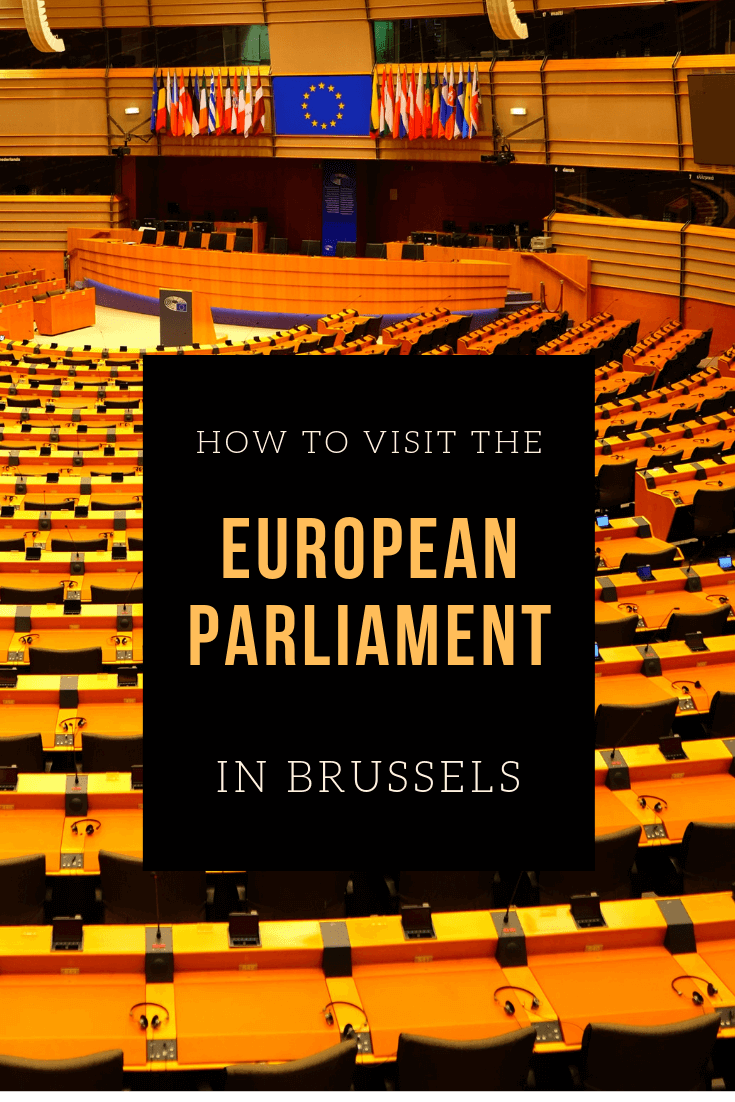
If you’re visiting Brussels, you might also like my other post about visiting Belgian breweries and beer tasting in Brussels .
Save for later or share with a friend
20 thoughts on “How to visit the European Parliament in Brussels and the EU Quarter”
These places are stunning! Pinning this now 🙂
Thanks Sarah 🙂
We only made a quick stop in Brussels years ago, would love to go back and explore more.
Ah, hope you get back to Brussels soon! I’m also hoping to go back!
I would love, love to visit the EU Parliament in Brussels! My friend and I actually walked by several of these buildings and monuments during our short weekend stay there, it was such a culturally rich city to visit!
It’s so interesting, I’m so glad we were able to catch a tour! There’s definitely a lot of fun and cultural things to do in Brussels.
Great post! I visited Brussels several years back on a university trip, specifically to visit the EU, and expected to find the city very bureaucratic- however, I was surprised by how beautiful it was! Definitely a great place to spend a few days 🙂
Same, I thought the European Quarter would be grey and boring and full of suits, but it was actually really pretty and vibrant. And everyone we met that day was so warm and funny. It definitely exceeded my expectations!
Helen, I enjoyed your post! I actually had a stay over in Brussels and I saw a little bit but I want to go back
Thanks Kiera, I hope you get back there soon, I’m also hoping to go back, three days wasn’t enough!
I have visited this area but did not take a tour of the Parliament for lack of time. I have fond memories of my trip to Brusselx as I went there with my mom, and I love mother-daughter trips. We were there only for a weekend so we didn’t have much time, and there was so much good food and great beer we needed to explore, too! 😀 Still, I think it’s an important institution and I would like to get there to learn more about it.
Haha I’m with you on the beer! And the delicious chocolate, and the frites!
I had no idea that you could visit! Really interesting post
Thanks Catherine 🙂
Very cool. I didn’t realize there was so much in the EU area!
There’s absolutely loads to do, definitely worth a day on a Brussels trip 🙂
What a lovely place to visit! This just makes me realize how much I missed by not going there, I was supposed to next week, but I have a scheduling issue and had to turn down the offer 🙁
Sorry to hear that,I hope you get to visit soon. It’s definitely worth a trip!
This is awesome- our boys love history and would love to see this. Pinned so I have this when we finally get them over to Europe! Someday!!!
Thanks Elizabeth, there’s so much to see in this area and you really feel the history behind what the European project wanted to achieve – all the wars and the division. Whatever you think of the modern EU it’s a fascinating part of Brussels.
Leave a comment Cancel reply
Save my name, email, and website in this browser for the next time I comment.
This site uses Akismet to reduce spam. Learn how your comment data is processed .
About Helen
40 before 40: How I visited 40 countries before my 40th birthday
Best travel podcasts 2020 according to travel bloggers.
European election 2024: When it is and key issues you need to know
- Medium Text
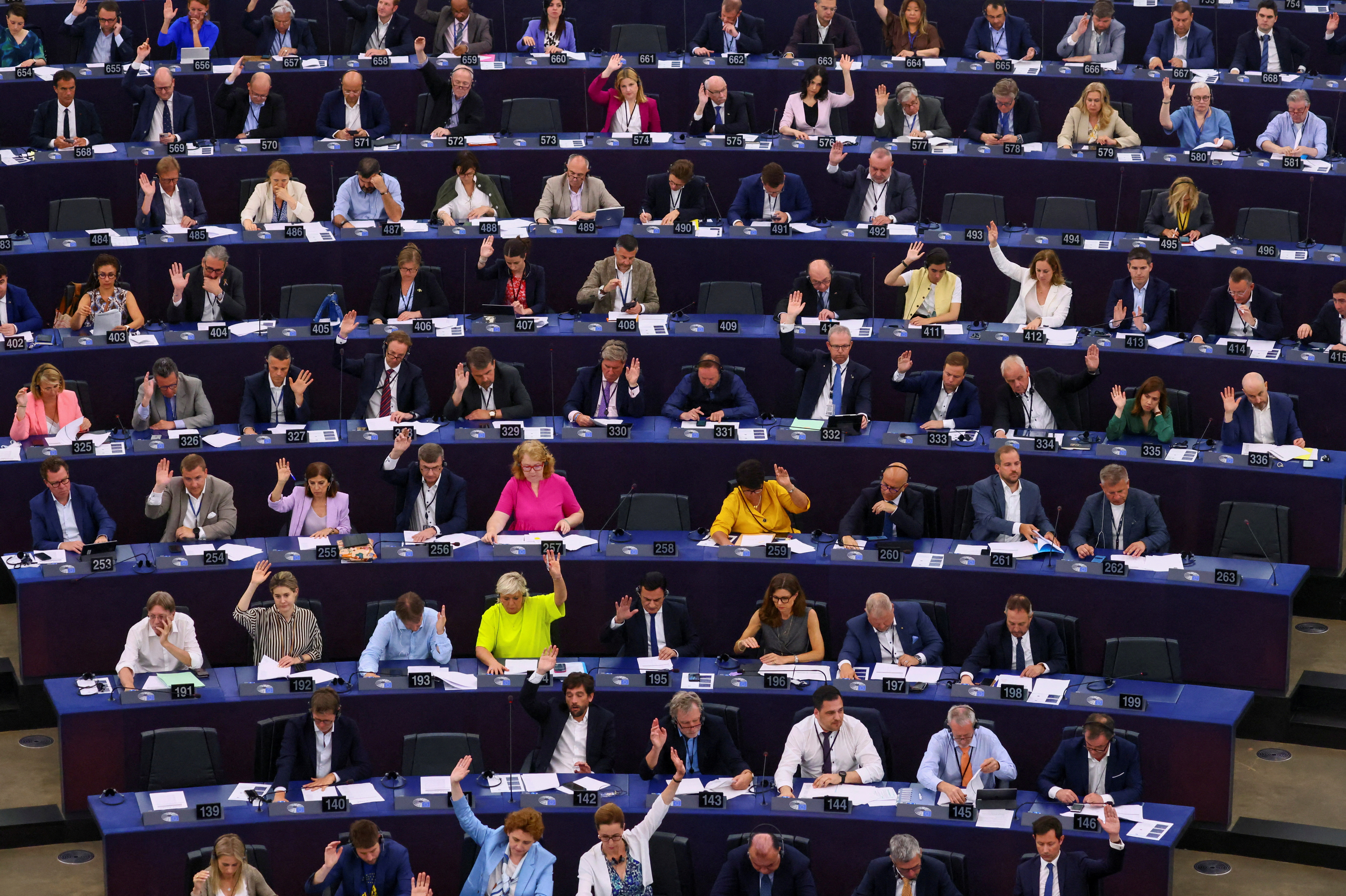
WHY IT IS IMPORTANT
Influence on key policies, influence on eu money, influence on future shape of eu.
Sign up here.
Reporting by Jan Strupczewski; Editing by Alison Williams
Our Standards: The Thomson Reuters Trust Principles. New Tab , opens new tab
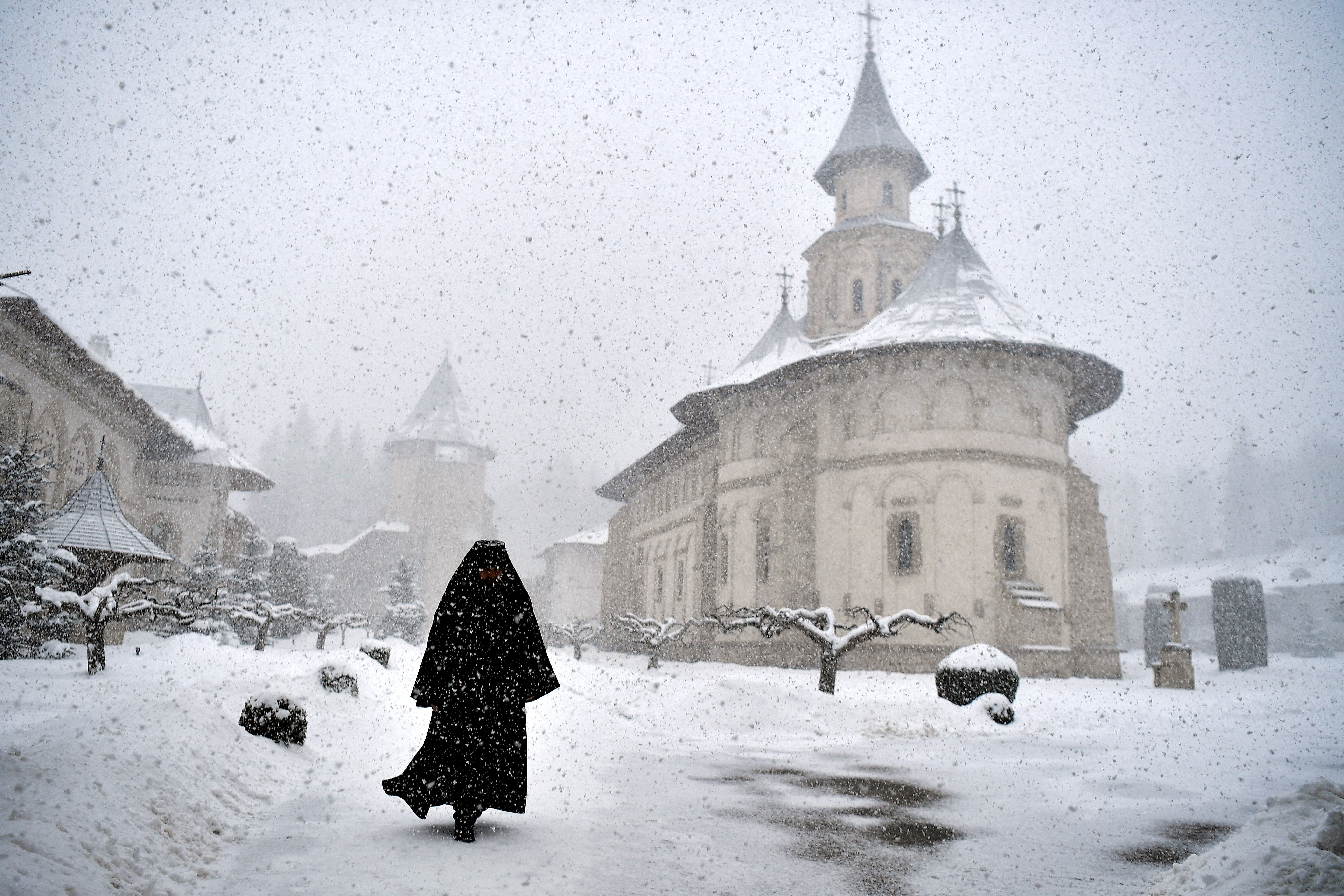
World Chevron

Blinken to meet Chinese counterpart Wang Yi in Beijing
U.S. Secretary of State Antony Blinken is due to meet Chinese Foreign Minister Wang Yi in Beijing on Friday for talks across a range of complex issues, including deepening strains over China's backing of Russia's invasion of Ukraine.

- Preplanned tours
- Daytrips out of Moscow
- Themed tours
- Customized tours
- St. Petersburg
Moscow Metro
The Moscow Metro Tour is included in most guided tours’ itineraries. Opened in 1935, under Stalin’s regime, the metro was not only meant to solve transport problems, but also was hailed as “a people’s palace”. Every station you will see during your Moscow metro tour looks like a palace room. There are bright paintings, mosaics, stained glass, bronze statues… Our Moscow metro tour includes the most impressive stations best architects and designers worked at - Ploshchad Revolutsii, Mayakovskaya, Komsomolskaya, Kievskaya, Novoslobodskaya and some others.
What is the kremlin in russia?
The guide will not only help you navigate the metro, but will also provide you with fascinating background tales for the images you see and a history of each station.
And there some stories to be told during the Moscow metro tour! The deepest station - Park Pobedy - is 84 metres under the ground with the world longest escalator of 140 meters. Parts of the so-called Metro-2, a secret strategic system of underground tunnels, was used for its construction.
During the Second World War the metro itself became a strategic asset: it was turned into the city's biggest bomb-shelter and one of the stations even became a library. 217 children were born here in 1941-1942! The metro is the most effective means of transport in the capital.
There are almost 200 stations 196 at the moment and trains run every 90 seconds! The guide of your Moscow metro tour can explain to you how to buy tickets and find your way if you plan to get around by yourself.
The European Parliament in Strasbourg – Outside plenary session
The european parliament in strasbourg – outside plenary session.
Experience the Hemicycle, the Parlamentarium Simone Veil and exhibitions at the European Parliament in Strasbourg.
Welcome to the official seat of the European Parliament ! All visits include the discovery of the Hemicycle, the Parlamentarium Simone Veil as well as permanent and temporary exhibitions .
Visits are free of charge, last around 60 minutes and are available in all 24 official languages of the European Union . Advance booking is not mandatory, but is recommended for groups.
Self-guided tours for visitors
Individual visitors and groups are welcome during the opening hours indicated below. During the visit you can use the ‘EP Visit Strasbourg’ app, which is available from the App Store and Google Play in the 24 official languages, or it can be used on the devices provided on site. At busy times there might not be enough devices for everyone. In this case, staff members will be on hand to answer questions and speak about the European Parliament in English, French and German. We invite you to bring your own headphones.
Opening hours
Please note that opening hours change during plenary sessions .
Last entrance : 17:00
The building is closed on Sundays and on the following days – 2024 : 01-05/01, 20/02, 29/03, 01/04, 26/04, 01/05, 9/05, 20/05, 15/08, 01/11, 23/12-05/01/2025.
Guided tours for groups
Groups (20 people or more) can book a guided tour. Guided tours are available in English, French or German . For part of the visit you can use the ‘EP Visit Strasbourg’ app, which is available from the App Store and Google Play in the 24 official languages, or it can be used on the devices provided on site.
Booking must be made at least two days in advance, but can be booked up to 6 months in advance.
Book a guided tour
The Alsace-Moselle Memorial in Schirmeck
Groups visiting the European Parliament in Strasbourg can also visit the Alsace-Moselle Memorial in Schirmeck for free during the same week of their visit . To benefit from free entry, groups must show their booking confirmation . If the visit was not booked in advance, groups can ask for a certificate during their visit to the European Parliament.
- Read more about the Alsace-Moselle Memorial in Schirmeck
Events and exhibitions
In addition to the not-to-be-missed visit to the Hemicycle, you can explore permanent and temporary exhibitions during your visit, or take part in one of the many events happening in the European Parliament throughout the year.
- Find out more about events and exhibitions
Accessibility
The European Parliament is committed to constantly improving access for people with disabilities. Should you or someone in your group require special assistance, please notify the visitor service in advance :
- Individual visitors
From Monday to Friday, a cafeteria is open in the visitor area.
Security and safety are priorities for the European Parliament. For that reason, a number of security measures are in place in and around our buildings. In order to ensure a safe visit for all, we invite you to read and comply with these measures:
- A valid identity document (national ID card or passport) is required to access European Parliament buildings. If you registered in advance and you provided your ID document details, you must bring this same document to the Parliament on the day of your visit.
- All visitors and bags are subject to airport-style security checks before entry. Firearms, explosive or inflammable substances, pepper sprays, sharp items and other objects that could be considered weapons are prohibited. In accordance with national legislation, certain prohibited items may be handed over to the police.
- No trolleys, suitcases, or other large luggage are allowed into the buildings.
- Animals are allowed in the buildings only as trained guides for visually impaired persons or to assist persons with reduced mobility.
- If an access pass has been issued, visitors must visibly wear it whilst in the Parliament buildings.
- Photography and filming are permitted inside the visitor area, but are prohibited in the security area and in the Hemicycle gallery during plenary sessions as well as in restaurants and bars. For more information, please consult the Rules Governing Recordings on the Premises of the European Parliament .
- If the fire alarm goes off, leave the building immediately without running and follow the instructions given by the security staff and evacuation volunteers.
- For any safety emergency, call 85112 from any internal phone.
- Some areas are subject to video surveillance in accordance with the European Parliament Video Protection Policy .
- If you feel unwell, please stay at home and postpone your visit. We will be happy to welcome you back when you are feeling better.
Last update: 11.2023
European Parliament
Louise Weiss building 1 Allée du Printemps F-67070 Strasbourg cedex
How to get there
Please consult the SNCF (French railways) website.
- SNCF
Bus line H (direct line). Bus lines 6, 30 and 72: ‘Droits de l’Homme’ stop (a 10-minute walk from the Parliament).
- Public transport in Strasbourg
Tram line E: ‘Parlement Européen’ stop.
Practical information
Bnu strasbourg.
BNU 6 Pl. de la République 67000 Strasbourg France
Brussels-Luxembourg serves the European Parliament
- Belgian Railways
Lines 22, 27, 34, 38, 64, 80 and 95 all stop at the European Parliament. Lines 12 and 21 also connect to Brussels Airport. The Zweig entrance in Rue D'Ardenne allows for pick-up and drop-off by bus and for visitors to get their bearings before starting the visit.
- Public transport in Brussels
- Download our practical information leaflet
The nearest stops are Maelbeek and Schuman on lines 1 and 5, and Trone on lines 2 and 6.
House of European History
Rue Belliard / Belliardstraat 135 1000 Brussels Belgium
Parlamentarium
Esplanade Solidarność 1980 Rue Wiertz / Wiertzstraat 60 B-1047 Brussels Belgium
All. du Souvenir Français 67130 Schirmeck, France
Citizens' Garden
Rue Vautier / Vautierstraat 68 B-1050 Brussels Belgium
Lines 22, 27, 34, 38, 64, 80 and 95 all stop at the European Parliament. Lines 12 and 21 also connect to Brussels Airport.

European Quarter
Esplanade Solidarność 1980 B-1050 Brussels Belgium
Brussels-Luxembourg serves the European Parliament.
Esplanade Solidarność 1980 B-1050 Brussels Belgium +32 2 28 48077
APOLLONIA EUROPEAN ART EXCHANGES
23 rue Boecklin 67000 Strasbourg
Closed for maintenance until further notice. Visitors to the European Parliament in Brussels can now leave their car in the car park, by sending the booking request at least one working day in advance of a visit.
- European Parliament Parking Request
Berlin wall
Europa experience paris.
Europa Expérience Paris 28, place de la Madeleine 75008 Paris France
Leopold Park
1040 Etterbeek
Louise Weiss Building 1 Allée du Printemps F-67070 Strasbourg cedex
Musée de la vie wallonne Cour des Mineurs 4000 Liège, Belgium
Europa Experience
Erlebnis Europa Vienna Rotenturmstraße 19 1010 Vienna Austria
Jean Monnet House
7 chemin du Vieux Pressoir, Houjarray 78490 Bazoches sur Guyonne France
Station Europe
Place du Luxembourg / Luxemburgplein 100 B-1050 Brussels Belgium
European Parliament Liaison Offices
Robert schuman building.
Place de l'Europe L-1499 Luxembourg
Esplanade Solidarność 1980
Paul-Henri Spaak Building Rue Wiertz / Wiertzstraat 60 B-1047 Brussels Belgium +32 (0)2 28 41482
Continue your visit
Role play game – strasbourg, events and exhibitions in strasbourg, the parlamentarium simone veil.
European Parliament Approves Human Rights 'Due Diligence' Directive
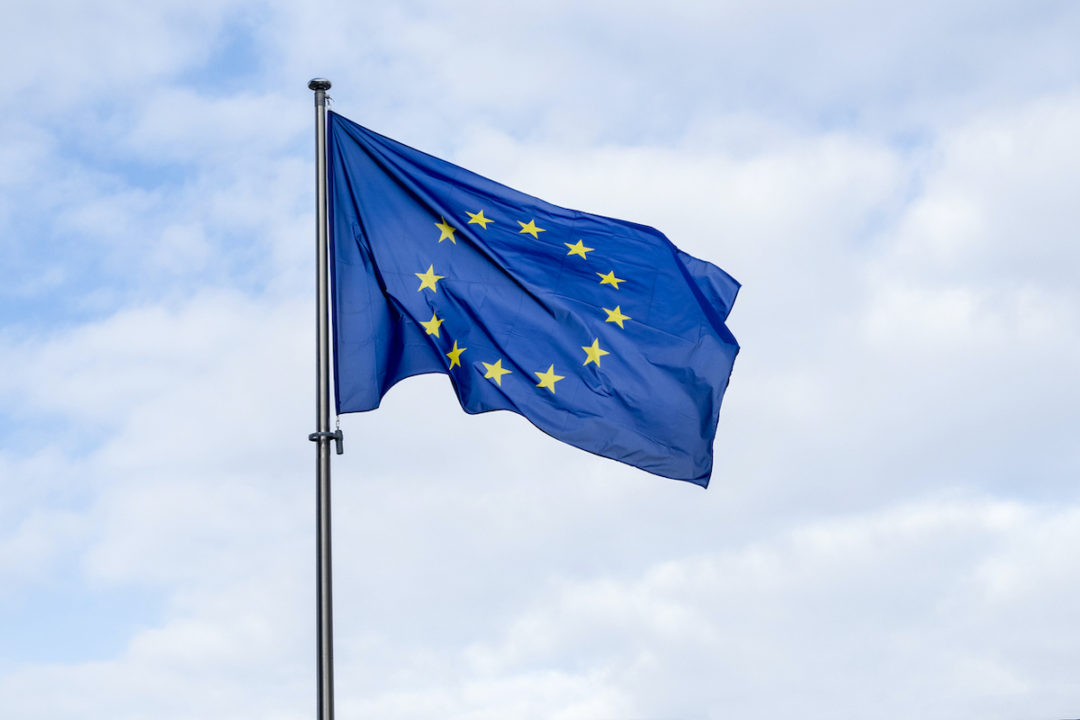
Photo: iStock.com/ AlxeyPnferov
The European Parliament has voted to approve legislation that requires large companies in the European Union to address sustainability and human rights impacts across their supply chains.
Parliament gave the so-called "due diligence" directive the green light on April 24. It makes it so that all EU companies with over 1,000 employees and a global turnover higher than €400 million ($427 million) must eventually mitigate against business practices like forced labor, pollution, and various other human rights abuses. It also allows the European Commission to investigate potential abuses in companies' supply chains in countries outside of the EU, and creates legal liability for any violations.
"Today’s vote is a milestone for responsible business conduct and a considerable step towards ending the exploitation of people and the planet by cowboy companies," said European Parliament lead member Lara Wolters. "This law is a hard-fought compromise and the result of many years of tough negotiations."
The legislation next needs final approval from the Council of the European Union before it's signed into the EU Official Journal. It will officially take effect 20 days after that. Then, EU member states will have two years to integrate the directive into their national laws.
RELATED CONTENT
RELATED VIDEOS
E-SMART Reverse Lets Companies Set Backing Speed Limits on Vehicles
Subscribe to our daily newsletter.
Timely, incisive articles delivered directly to your inbox.
Popular Stories

How Businesses Can Cut Supply Chain Costs Without Jeopardizing Long-Term Growth

Fashion Brands Make Earth Day Commitment to Preserve Endangered Forests

Podcast | Thinking Beyond Cost: New Executive Priorities for Supply Chains

Why Planning Isn’t Enough to Achieve True Operational Excellence

U.K. Brexit Import Checks Delayed, Causing Confusion
Digital edition.

2024 Supply Chain Management Resource Guide: There's Only One Way Off a Burning Platform
Case studies, recycled tagging fasteners: small changes make a big impact.

Enhancing High-Value Electronics Shipment Security with Tive's Real-Time Tracking

Moving Robots Site-to-Site
Jll finds perfect warehouse location, leading to $15m grant for startup, robots speed fulfillment to help apparel company scale for growth.
Explainer-Why You Should Care About the European Parliament Election

FILE PHOTO: Members of the EU Parliament vote during a plenary session at the European Parliament in Starsbourg, France June 13, 2023. REUTERS/Yves Herman/File Photo
BRUSSELS (Reuters) - European Union citizens will vote on June 6-9 in elections to choose 720 new members of the European Parliament (MEPs) for the next five years.
WHY IT IS IMPORTANT
The European Parliament is one of the three main EU institutions that run the 27-nation bloc. Along with EU governments, it decides on laws that govern common European policies and the EU market of almost 450 million people.
INFLUENCE ON KEY POLICIES
The parliament will shape crucial policies identified by EU leaders as priorities for the next five years:
- the EU's transition to net zero greenhouse gas emissions by 2050
Photos You Should See - April 2024

- industrial policy to keep the EU competitive against China and the United States
- an EU energy union to lower energy prices and make supply more stable
- a Capital Markets Union to help mobilise private money to pay for all that
- boosting the EU's defence production capabilities
INFLUENCE ON TOP EU JOBS
The results of the election will influence the choice of the next head of the European Commission, the executive arm that has the exclusive power to propose new EU laws.
While there is no such formal requirement, the political grouping that wins the election will have a strong argument that the next Commission head should come from its ranks.
INFLUENCE ON EU MONEY
The next European Parliament will co-decide with EU governments on the next EU budget for 2028-2034, which is now around 1.1 trillion euros ($1.18 trillion).
The next long-term budget might be increased and certainly will have to change in terms of spending priorities to take into account the possible enlargement of the EU to include Ukraine, Moldova and the Western Balkans.
INFLUENCE ON FUTURE SHAPE OF EU
EU officials and governments say the bloc needs to reform its internal agriculture policy and the way it supports its members to equalise standards of living across the bloc before it admits new countries, especially big ones such as Ukraine.
Many also say the EU needs to change how it makes decisions, reducing the need for unanimity, if more countries are to join.
If such reforms are proposed in the next five years, the parliament will have a crucial role to play in shaping them.
(Reporting by Jan Strupczewski; Editing by Alison Williams)
Copyright 2024 Thomson Reuters .
Join the Conversation
Tags: European Union , Europe
America 2024

Health News Bulletin
Stay informed on the latest news on health and COVID-19 from the editors at U.S. News & World Report.
Sign in to manage your newsletters »
Sign up to receive the latest updates from U.S News & World Report and our trusted partners and sponsors. By clicking submit, you are agreeing to our Terms and Conditions & Privacy Policy .
You May Also Like
The 10 worst presidents.
U.S. News Staff Feb. 23, 2024

Cartoons on President Donald Trump
Feb. 1, 2017, at 1:24 p.m.

Photos: Obama Behind the Scenes
April 8, 2022

Photos: Who Supports Joe Biden?
March 11, 2020

‘A Rule for the Ages’
Lauren Camera April 25, 2024

Sale? Ban? What’s Next for TikTok?
Laura Mannweiler April 25, 2024

The Status of the Cases Against Trump
Lauren Camera and Kaia Hubbard April 25, 2024

Economy Slows in First Quarter
Tim Smart April 25, 2024

A ‘Fork in the Road’ for Democracy
Lauren Camera April 24, 2024

Johnson at Columbia: ’Stop the Nonsense’
Aneeta Mathur-Ashton April 24, 2024

Moscow Metro Tour
- Page active

Description
Moscow metro private tours.
- 2-hour tour $87: 10 Must-See Moscow Metro stations with hotel pick-up and drop-off
- 3-hour tour $137: 20 Must-See Moscow Metro stations with Russian lunch in beautifully-decorated Metro Diner + hotel pick-up and drop off.
- Metro pass is included in the price of both tours.
Highlight of Metro Tour
- Visit 10 must-see stations of Moscow metro on 2-hr tour and 20 Metro stations on 3-hr tour, including grand Komsomolskaya station with its distinctive Baroque décor, aristocratic Mayakovskaya station with Soviet mosaics, legendary Revolution Square station with 72 bronze sculptures and more!
- Explore Museum of Moscow Metro and learn a ton of technical and historical facts;
- Listen to the secrets about the Metro-2, a secret line supposedly used by the government and KGB;
- Experience a selection of most striking features of Moscow Metro hidden from most tourists and even locals;
- Discover the underground treasure of Russian Soviet past – from mosaics to bronzes, paintings, marble arches, stained glass and even paleontological elements;
- Learn fun stories and myths about Coffee Ring, Zodiac signs of Moscow Metro and more;
- Admire Soviet-era architecture of pre- and post- World War II perious;
- Enjoy panoramic views of Sparrow Hills from Luzhniki Metro Bridge – MetroMost, the only station of Moscow Metro located over water and the highest station above ground level;
- If lucky, catch a unique «Aquarelle Train» – a wheeled picture gallery, brightly painted with images of peony, chrysanthemums, daisies, sunflowers and each car unit is unique;
- Become an expert at navigating the legendary Moscow Metro system;
- Have fun time with a very friendly local;
- + Atmospheric Metro lunch in Moscow’s the only Metro Diner (included in a 3-hr tour)
Hotel Pick-up
Metro stations:.
Komsomolskaya
Novoslobodskaya
Prospekt Mira
Belorusskaya
Mayakovskaya
Novokuznetskaya
Revolution Square
Sparrow Hills
+ for 3-hour tour
Victory Park
Slavic Boulevard
Vystavochnaya
Dostoevskaya
Elektrozavodskaya
Partizanskaya
Museum of Moscow Metro
- Drop-off at your hotel, Novodevichy Convent, Sparrow Hills or any place you wish
- + Russian lunch in Metro Diner with artistic metro-style interior for 3-hour tour
Fun facts from our Moscow Metro Tours:
From the very first days of its existence, the Moscow Metro was the object of civil defense, used as a bomb shelter, and designed as a defense for a possible attack on the Soviet Union.
At a depth of 50 to 120 meters lies the second, the coded system of Metro-2 of Moscow subway, which is equipped with everything you need, from food storage to the nuclear button.
According to some sources, the total length of Metro-2 reaches over 150 kilometers.
The Museum was opened on Sportivnaya metro station on November 6, 1967. It features the most interesting models of trains and stations.
Coffee Ring
The first scheme of Moscow Metro looked like a bunch of separate lines. Listen to a myth about Joseph Stalin and the main brown line of Moscow Metro.
Zodiac Metro
According to some astrologers, each of the 12 stops of the Moscow Ring Line corresponds to a particular sign of the zodiac and divides the city into astrological sector.
Astrologers believe that being in a particular zadiac sector of Moscow for a long time, you attract certain energy and events into your life.
Paleontological finds
Red marble walls of some of the Metro stations hide in themselves petrified inhabitants of ancient seas. Try and find some!
- Every day each car in Moscow metro passes more than 600 km, which is the distance from Moscow to St. Petersburg.
- Moscow subway system is the 5th in the intensity of use (after the subways of Beijing, Tokyo, Seoul and Shanghai).
- The interval in the movement of trains in rush hour is 90 seconds .
What you get:
- + A friend in Moscow.
- + Private & customized Moscow tour.
- + An exciting pastime, not just boring history lessons.
- + An authentic experience of local life.
- + Flexibility during the walking tour: changes can be made at any time to suit individual preferences.
- + Amazing deals for breakfast, lunch, and dinner in the very best cafes & restaurants. Discounts on weekdays (Mon-Fri).
- + A photo session amongst spectacular Moscow scenery that can be treasured for a lifetime.
- + Good value for souvenirs, taxis, and hotels.
- + Expert advice on what to do, where to go, and how to make the most of your time in Moscow.
Write your review
European Parliament updates trans-European transport network guidelines
Share this page: .
- Major transport links to finish by 2030
- Cut transport infrastructure ties with Russia and focus on Ukraine
- Create better conditions for military mobility along major EU roads and railways
On Wednesday, MEPs endorsed updated plans to complete major trans-European transport projects, such as cross-border roads, railways, bridges and tunnels, by the end of 2030.
To eliminate bottlenecks and missing transport links, MEPs backed an update of the EU’s plan to build a network of railways, roads, inland waterways and short sea shipping routes connected through ports and terminals across the EU. Current trans-European transport (TEN-T) projects include many European links, such as, Rail Baltica , connecting Helsinki and Warsaw, the Brenner Base Tunnel , linking Austria and Italy, and the Lisbon–Madrid high-speed rail line.
Major transport infrastructure projects on the core TEN-T network should be completed by the end of 2030, to secure a comprehensive network by the end of 2050. To accelerate project rollout across the network, an intermediary deadline of 2040 is introduced.
Faster trains and safer parking for truck drivers
MEPs ensured that railways in the core TEN-T network will be electrified, running at speeds of 100 km/h for freight and crossing internal EU borders in less than 25 minutes on average by the end of 2030. A minimum 160 km/h speed should become the norm on passenger trains as of the end of 2040.
Major European airports (processing more than 12 million annual passengers) will be connected to the trans-European railway network. To guarantee better rest conditions for professional truck drivers, safe and secure parking places at least each 150 km will have to be set-up along major EU roads.
End cooperation with Russia; focus on Ukraine
Under new rules, transport infrastructure projects with Russia and Belarus will be halted, reinforcing instead links with Ukraine and Moldova.
Regarding the involvement of companies from third countries in major TEN-T projects, member states will have to inform the European Commission of measures adopted to mitigate any security risk.
Military mobility
MEPs convinced EU governments to take into account military needs (weight or size of military transport) when constructing or upgrading infrastructure that overlaps with military transport networks, to ensure the seamless transfer of troops and equipment. Within one year after the entry into force of the rules, the Commission will have to conduct a study on short-notice large-scale movements across the EU, to facilitate military mobility planning.
EP rapporteur Barbara Thaler (EPP. AT) said: “The regulation will enable rail transport to compete with road transport, if it is implemented as foreseen. It is now the Commission’s responsibility to ensure that member states fulfil their duties and to put the necessary pressure on them if they don't act accordingly.”
Rapporteur Dominique Riquet (Renew, FR) added: “New rules will strengthen the performance, accessibility, security and resilience of our infrastructure, which is a key element of our sovereignty. It will also help to encourage Europeans to travel and make our economy more competitive.”
The new rules on the guidelines for the development of the trans-European transport network were adopted by 565 votes in favour, 37 votes against and 29 abstentions. Once Council has approved them, they will enter into force 20 days after publication in the Official Journal.
By adopting this legislation, Parliament is responding to citizens' expectations concerning high quality, modern, green, and safe infrastructure, ensuring connectivity, including of rural and island regions, in particular through affordable public transport as expressed in proposal four of the conclusions of the Conference on the Future of Europe.
Contacts:
Gediminas vilkas .
- Phone number: (+32) 2 28 33592 (BXL)
- Mobile number: (+32) 470 89 29 21
- E-mail: [email protected]
- Twitter account: @EP_Transport
Further information
- EU draft rules on trans-European transport network
- Procedure file
- EP research service note on TEN-T revision (March 2024)
Product information

Putin taunts the West with 'first ever' visit to remote ice-covered 'frontier region' just 55 miles from the US - as Zelensky tries to drum up war support in Lithuania
- Chukotka is Russia's easternmost region, sharing a maritime border with Alaska
President Vladimir Putin has arrived for his first-ever presidential visit to Chukotka in Russia 's Far East - just 55 miles from the US state of Alaska .
Putin arrived in Anadyr, the local capital of the Chukotka region this morning after flying from Moscow some nine time zones away.
Chukotka is the easternmost region of Russia, with a maritime border on the Bering Strait with Alaska.
The Russian president was met in Anadyr by a motorcade and was whisked away in a limousine amid frigid temperatures of -28C.
It's the closest he has come to US soil since he met with President Barack Obama in New York City in 2015.
Chukotka is so close to Alaska that Roman Abramovich - the ex-Chelsea FC owner - was reported to fly to Anchorage in Alaska for lunch when he was the governor of the region from 2001 - 2008.
Putin's visit comes at a time when US-Russian relations are at their lowest ebb in decades amid the war in Ukraine and a growing East-West divide.
Meanwhile, Ukrainian President Volodymyr Zelensky today landed in Lithuania as part of an unannounced trip to the Baltic states to drum up more support for the conflict.
Global war for control of the ARCTIC: Climate change is unlocking untapped natural resources, new trade routes... and a new international conflict that RUSSIA is already winning
The three Baltic states - all former Soviet republics which are now EU and NATO members - are among Ukraine's staunchest allies.
'Estonia, Latvia, and Lithuania are our reliable friends and principled partners. Today, I arrived in Vilnius before going to Tallinn and Riga,' Zelensky said on social media platform X, formerly Twitter.
'Security, EU and NATO integration, cooperation on electronic warfare and drones, and further coordination of European support are all on the agenda,' he said.
The Baltic tour marks Zelensky's first official trip abroad this year.
In Lithuania, a key donor to Ukraine, Zelensky said he will hold talks with the president, prime minister and the speaker of parliament, and meet with the Ukrainian community.
The visit comes as other Kyiv allies waver on fresh aid, nearly two years into Russia's invasion.
Ukraine has come under intense Russian shelling in recent weeks, retaliating with strikes on Russia's border city of Belgorod.
Zelensky has urged allies to keep military support flowing and held in-person talks with officials from the United States, Germany and Norway last month.
But an EU aid package worth 50 billion euros ($55 billion) has been stuck in Brussels following a veto by Hungary, while the US Congress remains divided on sending additional aid to Ukraine.
Following his trip to Chukotka, Putin is expected to visit several regions in the Russian Far East to boost his re-election campaign amid the war with Ukraine, which has seen more than 300,000 Russians killed or maimed.
He is due to stand in March, seeking another six years in the Kremlin.
The only Kremlin leader ever to travel to Chukotka previously was Dmitry Medvedev in 2008.
Putin's trip sees him escape a wave of ugly protests in western Russia over hundreds of thousands of people scraping by in freezing conditions due to breakdowns in communal heating supplies.
In Elektrostal, Moscow region, desperate residents say they have had no communal heating - which Russians routinely expect the state to supply usually through piped hot water - for the entire winter so far.
'We have been without heating since [9 October],' one resident said in a video circulating on Telegram.
'It is impossible to be in our homes… We are freezing! We are freezing! We are freezing!' they said.
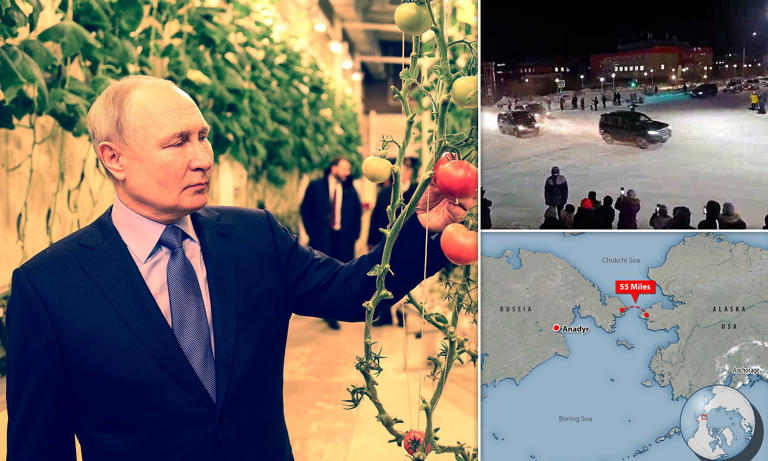

IMAGES
COMMENTS
Join in fun activities, lively debates, and learn about European institutions. This year, with the European Elections around the corner (6-9 June 2024), the European Parliament invites you to join engaging events all around Europe. Discover the programme and be part of the celebrations in Brussels, Strasbourg and beyond.
Visit the European Parliament's building in Brussels and learn more about how the Parliament works. Visits are free of charge and are available in any of the European Union's 24 official languages. It is fully accessible for visitors with disabilities. Book a visit for the plenary chamber in Brussels.
The Brussels hemicycle will be closed for Christmas from 24 December 2023 to 3 January 2024. Visit the Hemicycle, the heart of the European Parliament in Brussels, where Members of the European Parliament (MEPs) hold their debates and take crucial votes for Europe. A visit to the Hemicycle is a great way to soak up the exciting atmosphere of ...
Visiting the European Parliament is a unique opportunity for citizens to learn how EU parliamentary democracy works and how the decisions taken by the European Parliament are relevant to their daily lives. Parliament offers visitor a wide range of possibilities to get acquainted with the work, history, functioning of the Institution and the ...
Visiting the European Parliament, the only transnational parliament in the world elected in direct democratic elections, is a unique opportunity to discover the Chamber, where the MEPs from the 27 member countries of the European Union meet every month.. As you make your way through the building, including the Simone Veil Parlamentarium with its immersive, interactive exhibits, you'll come ...
The European Parliament has a number of venues in Brussels, for individual or group visits. This includes the 'hemicycles' where EU laws are debated and voted on, the EU's interactive visitor centre - the Parlamentarium - the House of European history and Station Europe. Plan your European Parliament visit (Brussels)
Visit European Parliament. 17,199 likes · 114 talking about this. Welcome to the official Facebook page of the European Parliament Visitors Services
The European Parliament in Strasbourg is open to visitors six days a week throughout the year.Visits are always free of charge.. During your visit, you can see the European parliamentary chamber - the Hemicycle, the Parlamentarium Simone Veil and several exhibitions. In Strasbourg, Members of the European Parliament meet twelve times a year during plenary sessions to debate and vote on ...
The Parliamentarium is the EU Parliament's official visitor centre, and has longer opening hours than the Parliament itself, so it's a great option if you can't make one of the Parliament tours. Like the European Parliament tour, visiting the Parliamentarium is free. The entrance is just off Espace Léopold, towards Rue Montoyer.
Visit the European Parliament European Commission. The European Commission visitors' centre welcomes visitor groups (minimum 15). It gives presentations and hosts discussions on the European Commission's role as the EU's political executive. Visits should be booked at least 10 weeks in advance and can be adapted to suit interests and age groups.
The European Parliament is one of the three main EU institutions that run the 27-nation bloc. Along with EU governments, it decides on laws that govern common European policies and the EU market ...
The German Green and former Transparency International campaigner has led Parliament's charge for the EU to stop funding corruption. After Ursula von der Leyen decided to unblock some funds for Hungary ahead of a European summit, Freund got the Parliament to launch a lawsuit against the Commission.
The European Parliament is the EU's only directly-elected institution. Its 705 Members are there to represent you. Go to the page Learn more about the European Parliament. ... Go to the page Visit us; Go to the page The Parliament on social media; Go to the page The Parliament in your country; Go to the page Another request? We are here to help.
Moscow Metro. The Moscow Metro Tour is included in most guided tours' itineraries. Opened in 1935, under Stalin's regime, the metro was not only meant to solve transport problems, but also was hailed as "a people's palace". Every station you will see during your Moscow metro tour looks like a palace room. There are bright paintings ...
The plenary session will take place from 22.04.2024 to 25.04.2024. Welcome to the official seat of the European Parliament! All visits include the discovery of the Hemicycle, the Parlamentarium Simone Veil as well as permanent and temporary exhibitions. Visits are free of charge, last around 60 minutes and are available in all 24 official ...
The European Parliament has voted to approve legislation that requires large companies in the European Union to address sustainability and human rights impacts across their supply chains.. Parliament gave the so-called "due diligence" directive the green light on April 24. It makes it so that all EU companies with over 1,000 employees and a global turnover higher than €400 million ($427 ...
Greek Supreme Court bans far-right Spartiates party from entering European elections. File Photo. Greece's Supreme Court has published the final list of parties that will compete in June's European elections with the roster excluding the far-right party Spartiates (the Spartans).. The ruling party New Democracy, along with opposition parties PASOK and New Left, filed a memorandum ...
The European Parliament is one of the three main EU institutions that run the 27-nation bloc. Along with EU governments, it decides on laws that govern common European policies and the EU market ...
Moscow Metro private tours. 2-hour tour $87: 10 Must-See Moscow Metro stations with hotel pick-up and drop-off. 3-hour tour $137: 20 Must-See Moscow Metro stations with Russian lunch in beautifully-decorated Metro Diner + hotel pick-up and drop off. Metro pass is included in the price of both tours.
A far-right Greek MP has been arrested after a punch-up in the country's parliament. Konstantinos Floros, a former member of the extreme Spartans Party, allegedly assaulted Vasilis Grammenos, from ...
By adopting this legislation, Parliament is responding to citizens' expectations concerning high quality, modern, green, and safe infrastructure, ensuring connectivity, including of rural and island regions, in particular through affordable public transport as expressed in proposal four of the conclusions of the Conference on the Future of Europe.
The Moscow Metro system is full of art, but there are hundreds of stations. Eliminate the risk of getting lost in the vast network, or missing the most important stations. On this handy private tour you'll be taken to the most interesting and impressive art and architectural examples, and learn all about their history and cultural significance from your local guide.
Putin's visit comes at a time when US-Russian relations are at their lowest ebb in decades amid the war in Ukraine and a growing East-West divide. ... and further coordination of European support ...